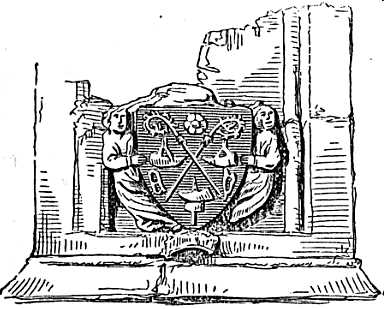

Page 2 of 14
Pennecuick who was a zealous partizan of the Polmood family, proceeds to record in an ecstasy of perfect faith that "the broad arrow is still in the house and the bow has been seen by several persons". They were doubtless as ancient as the charter; but be this as it may, Polmood was held by the Hunters from a considerably remote period and so ancient and so honourable a family needed not such questionable aid to inerease its widely and justly admitted antiquity.
Chambers in his History of Peebleshire after recording the extinction of this family in 1689, in the person of Robert Hunter of Polmood, the last legitimate representative gives an interesting account of the fortunes of his natural son George of the stranger in blood but of the same name who in 1765 succeeded to the designation and to the property and of the long and fiercely contested litigation of which the estate was the subject.
The records of the Lyon Office afford strong heraldic evidence of the common origin of the Hunters of Hunterston and of Polmood the ancient arms of the former as "Praefectus Venatorum Regiorum in Cuninghame", being on three hunting horns vert and of the latter are three hunting horns. The earliest example of these bearings now extant is to be found at Melrose Abbey where on a shield carved at the base of a now ruined niche on the fifth buttress from the south transept are sculptured the arms of Abbot Andrew Hunter.
Pennecuick who was a zealous partizan of the Polmood family, proceeds to record in an ecstasy of perfect faith that "the broad arrow is still in the house and the bow has been seen by several persons". They were doubtless as ancient as the charter; but be this as it may, Polmood was held by the Hunters from a considerably remote period and so ancient and so honourable a family needed not such questionable aid to inerease its widely and justly admitted antiquity.
Chambers in his History of Peebleshire after recording the extinction of this family in 1689, in the person of Robert Hunter of Polmood, the last legitimate representative gives an interesting account of the fortunes of his natural son George of the stranger in blood but of the same name who in 1765 succeeded to the designation and to the property and of the long and fiercely contested litigation of which the estate was the subject.
The records of the Lyon Office afford strong heraldic evidence of the common origin of the Hunters of Hunterston and of Polmood the ancient arms of the former as "Praefectus Venatorum Regiorum in Cuninghame", being on three hunting horns vert and of the latter are three hunting horns. The earliest example of these bearings now extant is to be found at Melrose Abbey where on a shield carved at the base of a now ruined niche on the fifth buttress from the south transept are sculptured the arms of Abbot Andrew Hunter.

© 1999 - 2022



These consist of two Abbots erosiers in saltire, with a stringed hunting horn below the heads of the crosiers on each side and what appears to have been overlooked, possibly from the decaying surface of the stone one also in base. It also displays a rose in the chief middle point, and a mason's mallet, Scoltice, Mell", on the base point of the shield a device for the name of Melrose his initials (A.D) are on the shield, one on each side below the hunting horns and two draped figures of angels and not mermaids as they have been deseribed, carry the shield between them supporting it with their hands on each side the raised wings of the angels being distinctly seen running back on the sides of the sculpture, and something like tho remains of a crown is placed under the point of the shield thus supporting it on the buttress below.
This Abbot Andrew Hunter was confessor to James II and filled many important offices from 1448 to 1460. He held the office of Lord High Treasurer of Scotland from 1449 till 1453.
Crawfurd the author of the "Peerage of Scotland", in noticing the rival families observes that they are both repute ancient officers of State. "The family of the south is styled Hunter of Polmood of whom nothing has been seen and that in the west is designed Hunter of that Ilk or Hunterston whose writs have very carefully perused. This family from charters appears to have had at least a part the estate they still possess in Cunninghame while the Morvilles were Lords of that country as far back as the reign King Alexander II".
The learned author of the "Historical Notes to Pont" above referred to endorses Crawfurd's statement in the following words, "This family would appear to have had possession at least of tho original territory of Hunter's-toun proper as early as the days of the De Morvilles, and it would seem at least probable that these lands were originally held in connection with an office relating to the chase in the semi regal establishment of the district, and he truly remarks in a further notice of the house of Hunterston, that "it is certainly pleasing to find that this very ancient family have ever continued in possession of this their original little territory through direct hereditary succession down to the present time a period of perhaps at least eight centuries whilst most of the principal barons and great landholders under De Morville have long utterly disappeared and have been forgotten in their wide domains and proud feudal prerogatives".
This Abbot Andrew Hunter was confessor to James II and filled many important offices from 1448 to 1460. He held the office of Lord High Treasurer of Scotland from 1449 till 1453.
Crawfurd the author of the "Peerage of Scotland", in noticing the rival families observes that they are both repute ancient officers of State. "The family of the south is styled Hunter of Polmood of whom nothing has been seen and that in the west is designed Hunter of that Ilk or Hunterston whose writs have very carefully perused. This family from charters appears to have had at least a part the estate they still possess in Cunninghame while the Morvilles were Lords of that country as far back as the reign King Alexander II".
The learned author of the "Historical Notes to Pont" above referred to endorses Crawfurd's statement in the following words, "This family would appear to have had possession at least of tho original territory of Hunter's-toun proper as early as the days of the De Morvilles, and it would seem at least probable that these lands were originally held in connection with an office relating to the chase in the semi regal establishment of the district, and he truly remarks in a further notice of the house of Hunterston, that "it is certainly pleasing to find that this very ancient family have ever continued in possession of this their original little territory through direct hereditary succession down to the present time a period of perhaps at least eight centuries whilst most of the principal barons and great landholders under De Morville have long utterly disappeared and have been forgotten in their wide domains and proud feudal prerogatives".
- Home
- Estate Land
- Gates
- Farms
- Watertanks
- The Brooch
- Castle
- Woods
- Ha-Ha Wall
- Hills
- Burns
- Dump
- Buildings
- Turret Bees
- Walled Garden
- Shores
- Mansion House
- Roads
- Bridges
- Trees
- Quarries
- Flora & Fauna
- Marshes
- Roman Features
- Geological Fault
- Industry
- Archaeology
- Other Features
- Hunter Clan
- Various Images
- Planning Documents
- Location Map
- Donate
- Contact Me

